
A post-00s trading prodigy from Shanghai now earns seven figures monthly and eight figures annually. Not only does she have a beautiful appearance and sound values, but her skills are also impressive, representing a new generation of post-00s. She is also a long-time friend in the crypto community. Recently, we discussed her glorious history during a meeting; she spent five years learning and practicing in the crypto space. She said making money is easy; many people overthink it. You just need to master the simplest candlesticks to trade, and her win rate is as high as 85%, achieving a record of 100 wins.
Through my own practice, I have also achieved a win rate of 80%. I have organized my findings over the past few days and am now sharing them with those who are destined to learn and master.
This shows the phases and time cycles of bull and bear markets in the crypto space over the years: four stages bear market - pre-bull market - bull market - super bull market, with each time period showcasing astonishing gains in the crypto market, revealing clear opportunities.
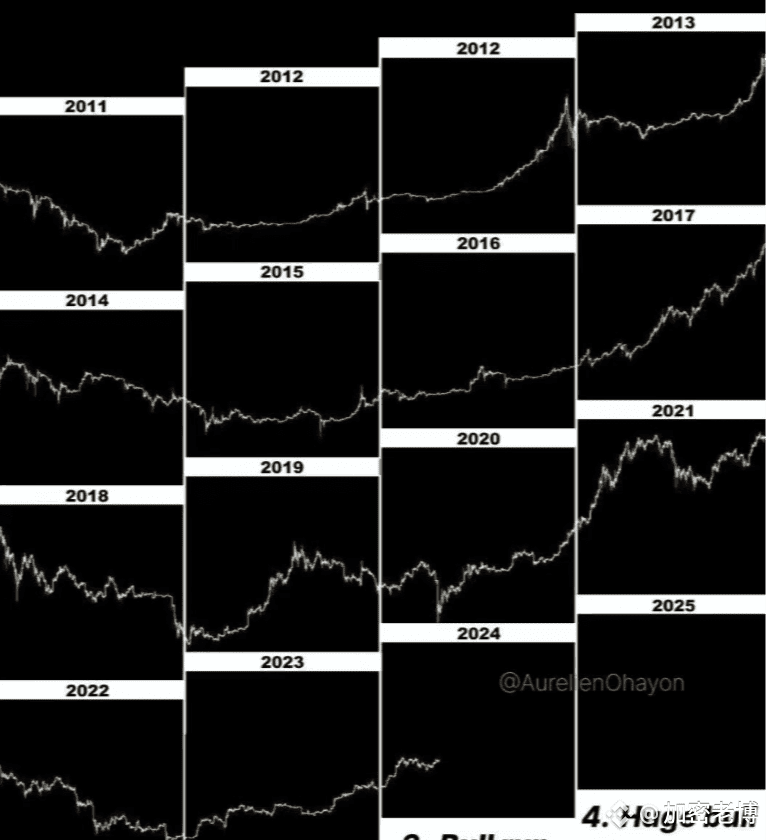
The cyclicality of Bitcoin is very strong. Here is a metaphor.
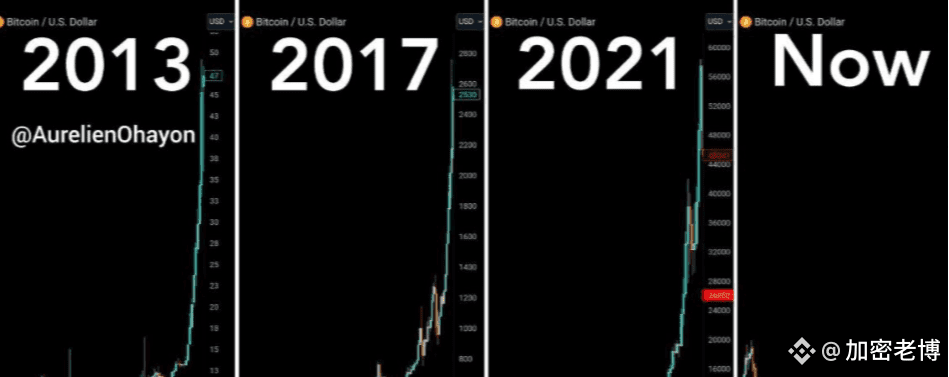
As shown in the above chart, the historical three halving cycles (2012, 2016, and 2020) all led to massive bull markets.
Now, with a monthly income of seven figures and an annual income of eight figures, the secret of wealth: by mastering candlesticks and recognizing patterns to trade, with a win rate of up to 100%.

In the digital currency market, technical analysis is a crucial indicator for predicting short-term market trends, commonly referred to as candlestick charts. Regardless of whether you believe in or respect technical analysis, understanding candlestick charts is essential.
Not understanding candlestick charts and making reckless trades is a big taboo in the crypto world! Excluding technical issues regarding chart patterns, indicators, and the battle between bulls and bears, basic information such as price trends, trading volume, minimum and maximum prices can all be reflected in candlestick charts.
What is a candlestick?
Candlestick charts are a must-have course for entering all secondary markets. We refer to candlestick charts as candle charts; they originated in the Edo period of Japan and were invented by Munehisa Homma, initially used to record rice market trends, and later introduced to the stock market and futures market due to their delicate and unique drawing method. Through candlestick charts, we can see the opening price, closing price, highest price, lowest price, and other price fluctuations within a specific period.
What is the use of looking at candlestick charts?
Can help you make better investment strategies, guiding you to choose the best times to buy and sell. For believers in accumulating coins, understanding this is also necessary, as most trading interfaces of major exchanges are dominated by candlestick charts. Not understanding them makes it difficult to fit in the crypto space.
What information can be gained from looking at candlestick charts?
Through candlestick charts, you can see price trends over specific periods (30 minutes, 1 hour, 1 day, 1 week...), including opening prices, closing prices, highest prices, and lowest prices. You can also see the intense battles between bulls and bears.
Highlighting key points
Components of the Candlestick Chart
The main components of candlestick charts are two: bullish lines and bearish lines.
Each candlestick represents four prices of the day: highest price, lowest price, opening price, and closing price. The section between the opening price and closing price is drawn as a 'rectangular body', and the highest and lowest prices are connected, combining to form the candlestick.
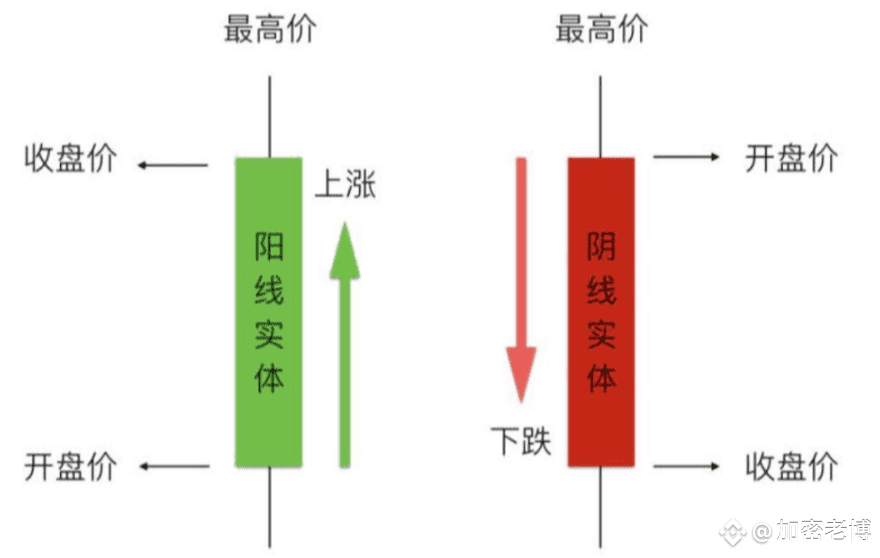
When the closing price is greater than the opening price, the body is green, indicating price increase, which we call a bullish line.
When the closing price is lower than the opening price, the body is red, indicating price decrease, which we call a bearish line.
Most exchanges and analysis software in the crypto space use green to represent bullish lines and red to represent bearish lines. Generally, bullish lines represent bulls (buying), and bearish lines represent bears (selling). The side with greater strength will have corresponding candlesticks in the candlestick chart.
Taking daily charts as an example: If the buying force is greater than the selling force today, then today's candlestick in the daily chart is a bullish line (green bar). Conversely, if a bearish line (red bar) appears, it indicates stronger selling force.
Note: In the Chinese stock market, bullish lines are red, while bearish lines are green; some charts may also represent bullish lines as solid bodies and bearish lines as hollow bodies.
What is a shadow line?
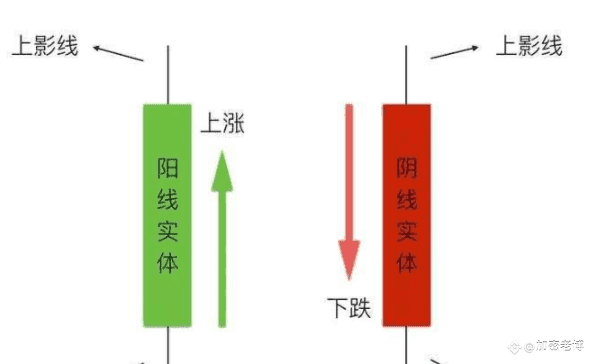
The shadow line is the thin line at the top and bottom of the candlestick, representing the difference between the day's highest and lowest prices and the closing price. The longer the shadow, the greater the resistance. A longer upper shadow indicates greater resistance to upward movement, while a longer lower shadow indicates greater resistance to downward movement. Regardless of bullish or bearish lines, the vertical line protruding upwards from the body is referred to as the upper shadow, and the line protruding downwards is referred to as the lower shadow.
What is the battle between bulls and bears?
Bulls and bears are two factions; the bulls represent the green faction, while the bears represent the red faction. Their viewpoints differ, with bulls believing prices will rise and bears believing prices will fall, often resulting in battles. The green faction consists of those who expect price increases and will buy to raise prices, while the red faction consists of those who expect price decreases and will sell to lower prices.
In every time period, battles will occur. If the bearish red army wins, prices will fall, and the candlestick chart will show red. If the bullish side gains a huge advantage, it indicates strength, and the entity shown in the candlestick chart will be larger. If the green side's resistance is weak, it indicates that the resistance posed to the red side is too small, and the shadow shown in the candlestick chart will be very short.
Small Bullish Star, Small Bearish Star

A. Small Bullish Star:
Represents very small fluctuations in the price of coins throughout the day, with the opening price and closing price extremely close, and the closing price slightly higher than the opening price.
The appearance of a Small Bullish Star indicates that the market is in a chaotic and unclear phase, making it impossible to predict future price movements. At this time, one should comprehensively judge based on the shape of the previous candlestick formations and the current price area.
B. Small Bearish Star:
The chart pattern of the small bearish star is similar to that of the small bullish star, except that the closing price is slightly lower than the opening price. This indicates a weak market with an unclear direction.
Small Bullish Line, Small Bearish Line

C. Small Bullish Line:
The fluctuation range of small bullish stars increases slightly, with the bulls holding a slight advantage, but the upward momentum is weak, indicating that the market is developing ambiguously.
D. Small Bearish Line:
Indicates that the bears are in a pressure state, but the intensity is not great.
Full-bodied Bullish Line, Full-bodied Bearish Line

E. Full-bodied Bullish Line:
① If a full-bodied bullish line appears in a low price area, it shows that after the price hits a bottom, it rises gradually with increasing trading volume, indicating the beginning of an upward trend. It illustrates that the price shows reduced trading volume during the bottoming process, and as the price gradually climbs, the trading volume expands evenly, ultimately closing as a bullish line, suggesting a bullish outlook for the future. If it appears during an upward trend, it indicates continued bullish sentiment.
② If an inverted hammer candlestick appears in a high price area, the price may be a sign that the main force is pushing the price up to sell off, which requires caution.
F. Full-bodied Bearish Line:
If this candlestick type appears in a low price area, it indicates that the intervention of bottom fishing has led to signs of price rebound, but the force is not strong.
Lower Shadow Bullish Line, Lower Shadow Bearish Line

G. Lower Shadow Bullish Line:
Its appearance indicates that the bullish attack in the battle between bulls and bears is steady and powerful; the price first falls and then rises, with potential for further upward movement.
H. Lower Shadow Candlestick:
When appearing in low price areas, it indicates strong support from the lower side, and there is a possibility of price rebound.
Upper Shadow Bullish Line, Upper Shadow Bearish Line
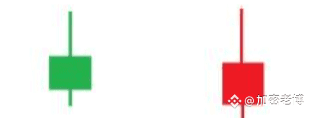
I. Upper Shadow Bullish Line:
① Indicates strong selling pressure from the upper side when the bulls are attacking. This pattern is common in the main force's testing actions, indicating that there are many floating chips at this time and upward momentum is weak.
② Indicates that the bullish attack is blocked and retreats, with heavy selling pressure above. It is unclear whether it can continue to rise.
J. Upper Shadow Candlestick:
When appearing in high price areas, it indicates severe selling pressure above, indicating weak market conditions, with the possibility of price reversal downwards; if it appears during a price rise at mid-price levels, it indicates that there is still room for upward movement.
Full-bodied Bullish Line, Full-bodied Bearish Line
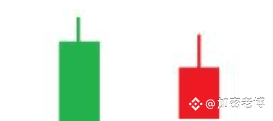
K. Full-bodied Bullish Line:
Indicates strong upward momentum, but at high price levels, there are divergences between bulls and bears, so caution is advised when buying.
L. Full-bodied Bearish Line:
The appearance of a full-bodied bearish line indicates that although the price of coins has rebounded, there is heavy selling pressure above. The bears take advantage of this to push the price down, resulting in a bearish closing.
Full-bodied Bullish Line with Upper Shadow, Full-bodied Bearish Line with Upper Shadow

M. Full-bodied Bullish Line with Upper Shadow:
① The bulls have gained an advantage and are showing a gradual upward trend in price; supported by trading volume, the price steadily rises, suggesting a bullish outlook for the future.
② Similarly, if a full-bodied bullish line appears, and the price trend shows a sideways or downward pattern for most of the time, followed by a sudden surge at the close, it may indicate a gap up before a decline.
③ If the price trend shows a wide fluctuation throughout the day, ending with a volume increase and a bullish close, it may indicate that the main force is using oscillation to wash out the weak hands and then easily push the price higher, with a bullish outlook for the future.
N. Full-bodied Bearish Line with Upper Shadow:
In contrast to the aforementioned full-bodied bullish line, it indicates a higher likelihood of price decline.
Full-bodied Bullish Line, Full-bodied Bearish Line
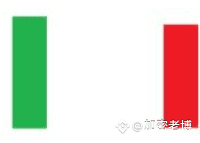
O. Full-bodied Bullish Line with Upper Shadow:
Indicates that the bulls have firmly controlled the market, gradually pushing upward, and the upward momentum is strong.
P. Full-bodied Bearish Line with Upper Shadow:
When the price is sideways, a sudden volume surge at the end indicates that the bears have ultimately gained the dominant advantage in the battle, making a low opening more likely.
If the price trends show a series of downward movements, it indicates that the bears have taken complete advantage, and the bulls have no strength to resist, leading to a gradual decrease in price, with a bleak outlook for the future.
T-shaped Line, Inverted T-shaped Line

Q. T-shaped line:
When appearing in low price areas, it indicates strong support from the lower side, and there is a possibility of price rebound.
R. Inverted T-shape Line:
When appearing in high price areas, it indicates severe selling pressure above, weak market conditions, and a possibility of price reversal downwards.
If it appears during an upward trend at mid-price levels, it indicates that there is still room for upward movement.
Cross Star
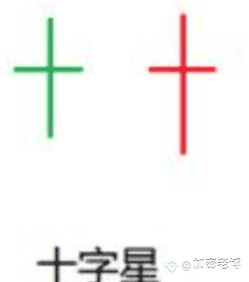
S. Cross Star:
This type of candlestick is often referred to as a reversal cross star; whether it appears in a high price area or a low price area, it can be seen as a signal for a top or bottom, indicating that the overall trend is about to change.
Summary of Candlestick Types
In addition to subdividing candlesticks into 19 types as mentioned above, we can categorize candlestick types based on their body and shadows. They can mainly be divided into four categories.
①: A candlestick with only a body and no upper or lower shadows is called a full-bodied bullish or bearish candlestick.
Indicates that one party is dominant among buyers and sellers, becoming the master of market transactions.
②: Small bearish and small bullish candlesticks without upper or lower shadows.
When the closing price is the highest or lowest price, and the opening price is the lowest or highest price, with limited fluctuations, and the battle between buyers and sellers is not intense, when the candlestick is a bullish line, the buyers have a slight advantage; when it is a bearish line, the sellers have a slight advantage. It generally appears when the price is consolidating or gapping up or down. Its significance is minimal during the consolidation period, but when there is a significant gap, its significance is extraordinary, indicating one side has achieved complete victory while the other side collapses.
③: A full-bodied bullish line without upper or lower shadows.
Often appears during a market rise, as the price continues to rise; although there are corrections, it quickly resumes upward movement, with buyers determined to push prices higher.
④: A full-bodied bearish line without upper or lower shadows.
Often appears during a price decline, with the opposite significance of the above.
In the digital currency market, technical analysis is a crucial indicator for predicting short-term market trends, commonly referred to as candlestick charts. Regardless of whether you believe in or respect technical analysis, understanding candlestick charts is essential.
Not understanding candlestick charts and making reckless trades is a big taboo in the crypto world! Excluding technical issues regarding chart patterns, indicators, and the battle between bulls and bears, basic information such as price trends, trading volume, minimum and maximum prices can all be reflected in candlestick charts.
Candlestick Patterns
Using candlestick patterns to provide us with double assurance and confidence.
Triggers our trades, so mastering candlestick patterns is equally important.
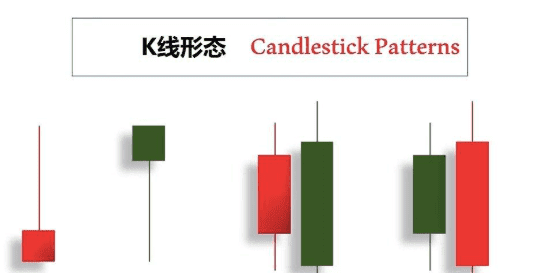
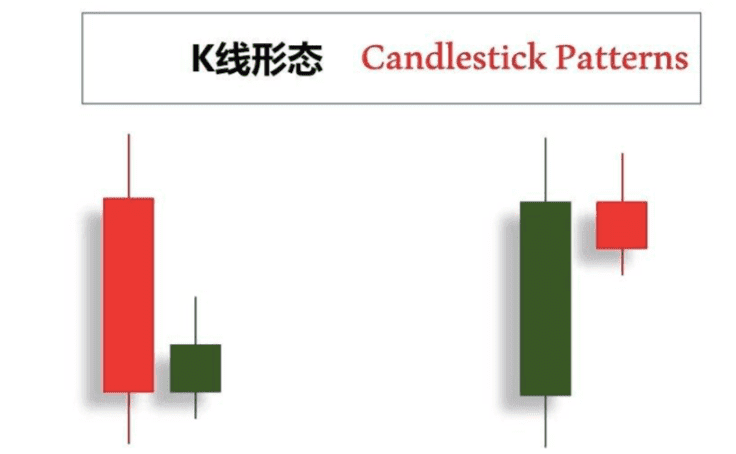
A bullish engulfing pattern consists of a bearish candle followed by a very small bullish candle, which, whether in body or shadow, is within the previous bearish candle.
The bearish engulfing pattern is the opposite, where the body and shadow of the bearish candle are both within the previous bullish candle.
Generally, there are two common methods to trade using this pattern.
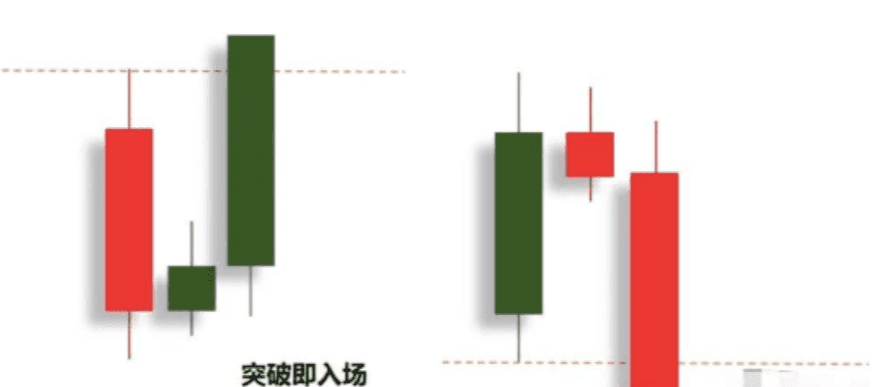
The first one, when the price breaks through the high or low of the previous candlestick, regardless of whether the latest candlestick has ended, we will enter a buy or sell position, which belongs to left-side trading.
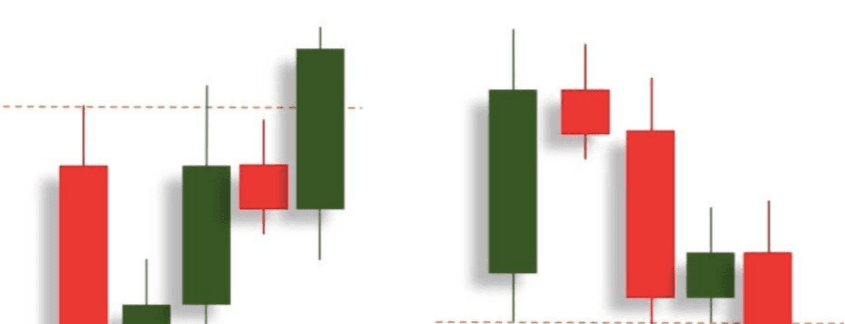
The second, more conservative approach is to wait for the current candlestick to truly end at the high or low of the previous candlestick before firmly establishing the direction before entering.
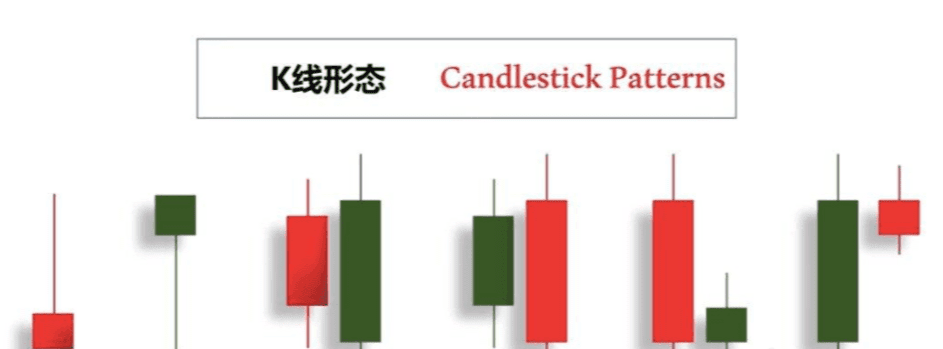
Part Three: Chart Patterns
You will find that the market continuously does one thing through repetitive patterns, and chart patterns provide such a trace, allowing us to see what the market is doing at this moment and the logic behind it.
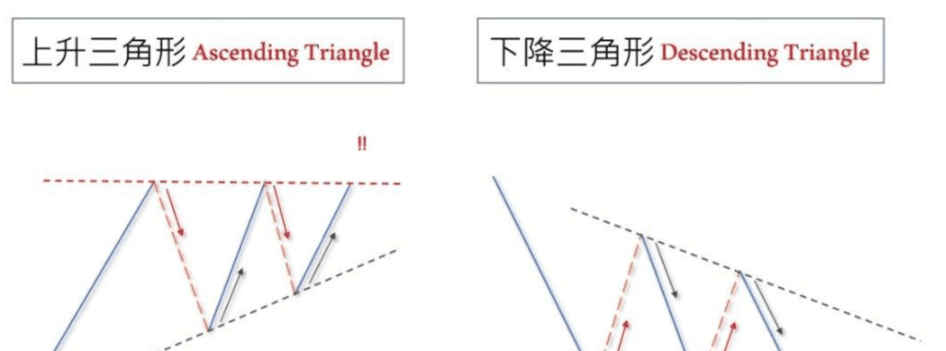
Common chart patterns often seen in the market.
Ascending Triangle
Descending Triangle
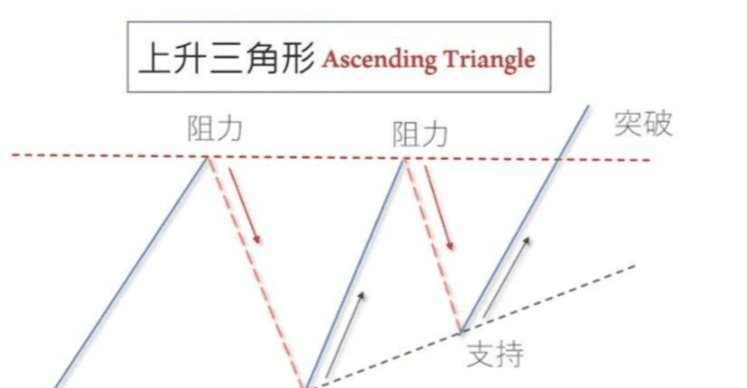
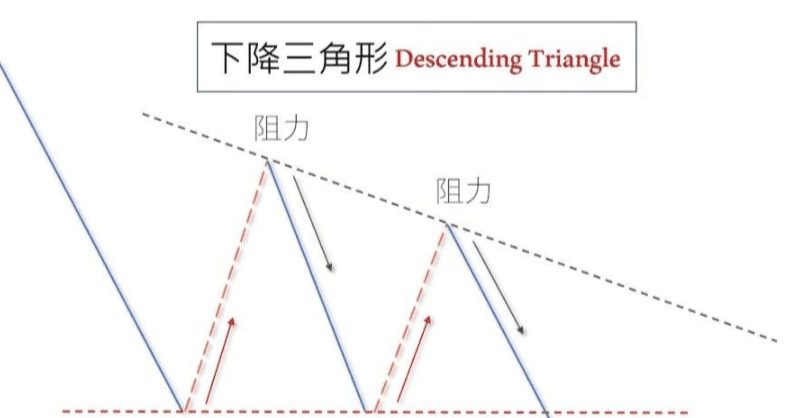
The descending triangle is the same; the impact of horizontal support levels on price, each break is less significant, and ultimately the breakthrough is successful, continuing a downward trend.
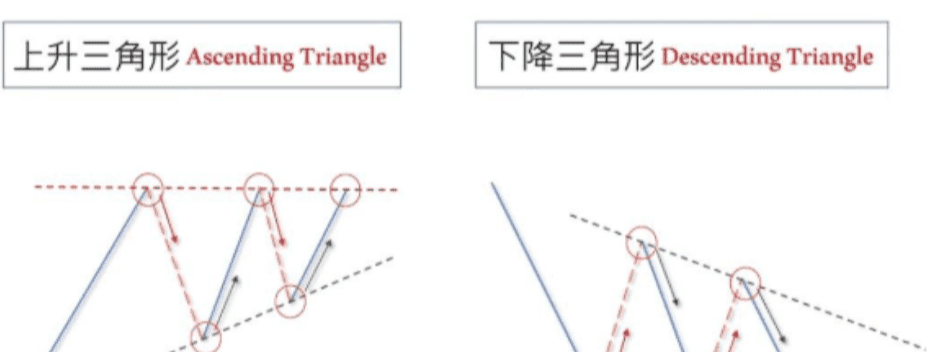
In this long bear market, where is the end? In the current market situation, many people can no longer endure. They face two choices: the first is to stop moving forward and exit the crypto space, the second is to endure and wait for the next bull market to begin.
Only a small portion of people can survive in a bear market. A bull market is like a windfall, where even pigs can fly, while a bear market is a battlefield where only the strong survive. So how can one survive in a bear market?

Locking in positions, staying away from the crypto market, and waiting for the next bull market to return. This rule requires high self-discipline; very few can truly ignore and detach themselves, and those who can do so are extraordinary.
Regular investment to reduce risk. Suitable for those with small initial investments and stable personal income, with future returns not likely to be low.
Timing the market for bottom fishing. This risk is also quite significant; it's not easy for novices to avoid being caught in a middle position, turning short-term trades into long-term holdings, which is not something just anyone can do well.
Short-term operations, buying high and selling low. Risk level five stars, greater than the fourth type. Those who do this well won't get trapped in a bear market.
Cutting losses and staying away from the crypto market, don't look back. The downside of this rule is that if you sell at the end of a bear market, followed by a super bull market, you will regret it for life. To avoid such regrets, this plan is not recommended.
How should we invest and trade in a bear market?
One: Stick to long-term investment plans that align with financial goals
For investors, whether in a bear market or a bull market, it is essential to stick to a long-term investment plan. During bear markets, there is an abundance of pessimistic information online, but it is best to ignore these market noises and focus on long-term investment returns. Some short-term traders quickly change their investment strategies to protect their funds or expand their returns, but the fact is, if you find yourself in a bear market, it may already be too late to change your asset allocation.
Two: Avoid timing the market for entry and exit
A common mistake for retail investors is trying to avoid the bear market by selling their positions. Exiting at highs and entering at lows seems simple but is actually not easy; even if an investor sells their position before a downturn, they may not be able to catch the timing to re-enter, as the market often surges unexpectedly when it seems bleak. Looking back at history, general investors exiting during a bear market prevents them from maximizing returns on their assets.
Three: Never attempt to time the market tops and bottoms
In a bear market, investors often want to sell all at once, but actually, selling in batches may be a better choice. Don't try to assess the timing of entering and exiting; relatively speaking, the average cost method (whether buying or selling) is more suitable.
Four: Accumulating Coins
Regular investment in accumulating coins. Most of the chips on the market are very cheap; accumulating cheap chips is what bears do, and coins accumulated in a bear market become the chips to profit in the next bull market.
Five: Strengthen theoretical learning and explore potential coins.
Learning is the key to continuous improvement. This field is ever-changing, with projects emerging constantly and technology being updated and iterated. If you don't learn, you will be eliminated. During this bear market, strive to learn and accumulate knowledge as chips for future battles.
The above is the trading experience that the old blogger shared with everyone today. Many times, you lose many opportunities to make money because of your doubts. If you don't dare to try boldly, to explore, to understand, how can you know the pros and cons? You can only know the next step after taking the first step. A warm cup of tea and a word of advice, I am both a teacher and a friendly conversationalist.
Meeting is fate, knowing each other is destiny. The old blogger firmly believes that those destined to meet will eventually do so, while those without fate will merely pass by. The journey of investment is long, and temporary gains and losses are just the tip of the iceberg along the way. One must understand that even the wisest will have losses, and the foolish will occasionally gain. Regardless of emotions, time will not stop for you. Pick up your worries and stand up to move forward again.
Still the same, in a bull market, if you don't know what to do, click on the old blogger's avatar, follow, and join the bull market spot planning, contract password, and share for free.


